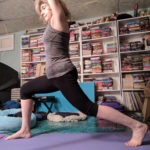It’s a new year, new resolutions, but same sad statistics. Here’s a short video I posted today on Facebook. A man in northwest Indiana lost his mom the day after Christmas because she lost her balance while taking out the trash and died of hypothermia. She had been waiting to see a doctor for balance-related issues. Granted, some balance issues need medical support and prescriptions, but it’s been proven that simple exercises can improve balance dramatically. Just a couple of minutes every day in the comfort of your own home can improve balance. Especially in the winter, this is so important. Much of the country has seen slick conditions in the last week. If a couple of minutes a day can help to prevent a fall, wouldn’t you want to do that?
Category: General Health
Lazy? Procrastinator?
 Yup, that’s me! My sister says I’m not lazy, but here it is, more than a month since I’ve posted here and I feel terrible about it.
Yup, that’s me! My sister says I’m not lazy, but here it is, more than a month since I’ve posted here and I feel terrible about it.
Paper and pen!
I have tried to be consistent, but obviously that’s not working on its own. I need help! So I’m going to be using a real, paper, appointment book, and using pen and ink, to remind me every day to write. I may not post here every day, but I’ll be writing and polishing.
They say that you have to do something consistently 30 times or so before it becomes a habit. The same thing, at the same time every day. I’ve gotten to the point where exercise has become a habit. I don’t enjoy it, but it’s a habit, and I feel like something’s missing if I miss more than a day of exercise. I don’t even have to schedule it on my calendar.
So, I’ll be writing my little heart out every day at 9:00 in the morning for about a half hour. I don’t know the topics, yet. Very often I just “write off the cuff,” as it were, and that could be the problem. Too often I think to myself, “I should write a blog post,” and then can’t think of a topic… What might work is keeping a topic list and consulting that when nothing occurs to me.
Organization module?
I’ve toyed with the idea of having an “Organization” module – heaven knows I need one that works for me. I’ve tried many, and have been enthusiastic about it at first but it becomes too much and I drift away.
I’ve discovered that part of “Fitness” is having a fit mind – and if I’m completely disorganized, I feel that I’m falling down on my fitness.
So, anyone out there who’s reading this – how would you feel about including “Organization” as part of “Fitness?”
Feed a cold?
 Apparently what I was feeling was not that I didn’t want to work out – it was actually a really bad cold. And I’m just not used to being sick. I can’t even remember the last time I had a cold. I eat right. I drink plenty of water, so perhaps my immune system is a little stronger than many others’. People around me can be sneezing, hacking, snorting and blowing their noses, and I don’t catch their nasty germs.
Apparently what I was feeling was not that I didn’t want to work out – it was actually a really bad cold. And I’m just not used to being sick. I can’t even remember the last time I had a cold. I eat right. I drink plenty of water, so perhaps my immune system is a little stronger than many others’. People around me can be sneezing, hacking, snorting and blowing their noses, and I don’t catch their nasty germs.
Until now.
A good friend was visiting from Minnesota a couple of weeks ago. She stayed with us for a few day, and we love having her. Usually. She complained of starting to feel sick the day after she arrived, so we fed her chicken soup and she took some Chinese herbs. And she was feeling better in a couple of days.
Those were apparently mighty strong Minnesota germs. The day after our friend left, my sister came down with a cough and cold. And then a couple of days later it hit me.
Like a ton of bricks.
I hate having a cold. When I have a bad one I will use up an entire box of tissues. My nose will not stop running. Where does it all come from? I hate to be in public, just because I’m so disgusting! I hate needing a tissue against my nose all the time… but I hate dripping more. And eating is ridiculous. Forget about eating around others! Nasty!
And then the sore throat. That was just adding insult to injury. When I was younger, when I got sick it started with a sore throat. This time the sore throat kicked in when I thought I might feel better in the next day or so. It could have been post-nasal drip (there was certainly enough drip for that!), but whatever led to the sore throat it was just disheartening. I really didn’t want to take anything for the sore throat because all the lozenges out there taste so horrible. And tea with honey only helps as long as the tea lasts. And gargling with warm salt water is a temporary and messy solution.
And then the cough. Yes, I’ve had some fun over the last week.
Fortunately I think I’m over it now and can go back to my regular life. I’ll try not to complain too much any more.
But I wish our friend had left her Chinese herbs with us…
I really don’t feel like it…
Being an adult means …
Don’t feel like it. No how, no way. But part of being an adult is doing stuff you don’t want to do.
We had a plumbing problem a couple of days ago. One of the drawbacks of living in an older house is old plumbing. About 10 years ago we re-piped most of the house with pretty new copper pipes because we redid a bathroom and had to open walls. All the galvanized pipes that were reachable were replaced.
But the kitchen was not included in the re-pipe. So the kitchen had 60-year-old pipes. And those pipes were prone to clogs. We’d been able to deal with those clogs up until a couple of days ago. Nothing we did solved the problem. We could not reach that stubborn clog.
We undid the pipes we could reach and cleaned them out. We tried using a water blaster. Nope.
Next day …
So we put the problem on hold until the next morning because there wasn’t anything else to do that night. I washed the dishes in the bathroom and my sister called the plumber. The dogs were confused…
 And now, we have brand new pipes in the kitchen.
And now, we have brand new pipes in the kitchen.
But the point is that our plumbing problem was not going to go away by itself. And nobody else was going to solve the problem. We had to be adults and figure it out.
What an adult does
Besides being able to do what you want to do when you want to do it, being an adult means making sure the bills get paid on time. Taking the dogs out on schedule.
Being an adult means eating healthy (most of the time) so that you can live a long and fulfilling life.
And being an adult means working out when you really, really don’t feel like it.
And when it’s done it won’t be weighing on you. You won’t have to remember it for tomorrow.
And being an adult means you get to do everything all over again tomorrow.
Got sleep?
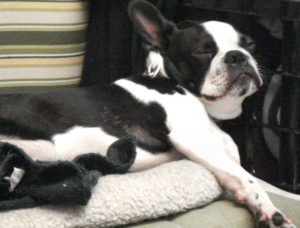 We all know that sleep is important for our health and fitness. And we don’t get enough of the right kind of sleep. We have trouble falling asleep. We have trouble staying asleep. And then we have trouble getting back to sleep. Lack of sleep affects our health. We’re sluggish, don’t move as much, eat more. Our productivity is diminished.
We all know that sleep is important for our health and fitness. And we don’t get enough of the right kind of sleep. We have trouble falling asleep. We have trouble staying asleep. And then we have trouble getting back to sleep. Lack of sleep affects our health. We’re sluggish, don’t move as much, eat more. Our productivity is diminished.
About sleep
There are three phases of sleep: light, deep and REM (rapid eye movement). We usually start with light sleep and move to deep sleep. Then it’s back to light sleep and REM, when we dream.
The cycle
Deep sleep happens most during the first part of the night usually, and is very hard to wake from. You’ll spend about a quarter of your night in deep sleep and a quarter in REM, which is easy to emerge from.
Deep sleep helps you feel rested
You can survive on just light sleep and REM, but deep sleep is the phase that helps you feel most rested. It’s what we crave from spa treatments and pills
Pills won’t do it!
But we can’t rely on pills to take us into deep sleep. Too often when we wake from a medicated sleep we feel foggy.
Try a cave!
If you want real deep sleep, turn off all your lights. Make your bedroom a cave.
Meditation works too! If you’re new to meditation and have heard of its benefits, try guided meditation – send me a message and I’ll email you one of the short guided meditations I’ve created in mp3 format. They’re restful and soothing (and free). Just the thing to help you sleep!
Don’t let them squash your joy!

I’ve talked about the ups, and downs, and more downs, and frustrations of dog training here. It’s part of my life, so I talk about it. I train my Boston Terrier, Booker in Obedience. I’m holding him in the picture to the left. To our right is the judge at the Obedience Trial where we earned Booker’s Novice Obedience title.
Doing Obedience with a Boston takes a great deal of patience and consistency. You don’t see many at Obedience trials. You see lots of Golden Retrievers and Border Collies.
Bostons are goofballs. It takes about 3 years for their brains to start to settle in. All they want to do is play, eat, play, sleep, and play some more. To earn an obedience title on a Boston takes a whole lot of persistence.
And now that we’ve earned the first regular title in AKC (American Kennel Club – the organization in which Booker is registered), I aim to continue and progress to the next level. Which will take even more training and practice and persistence and patience and consistency.
Back to the main theme…
Booker and I earned that title in 3 days this Spring. Since we earned the title all in one year, we’re qualified to enter the AKC Obedience Classic. Every dog that earned a title all in one year is eligible to enter the Classic.
As any user of Facebook does, I was scrolling through my groups and newsfeeds today. And there is a long discussion that the Classic is nothing more than a money-maker for the AKC.
That may certainly be one reason to hold the trial, but I’m not looking at it like that.
The Obedience Classic is a venue to show how proud the competitors are of the work they put in. Proud of their dogs and their training. It’s a chance for all of that training to be recognized in a venue where people may observe that might be inspired to train their own dogs.
The Classic is held at the place where the Agility Invitational and the National Dog Show is held. But people who may get tired of the noise could stop in to watch some of the best teams in the country compete. Watch the bond these teams have – person and dog – nothing better!
So, for those who say that anyone can get in to the Obedience Classic, and that it’s nothing more than a regular show, I don’t buy it. It demonstrates the love and passion a person has for their dog!
Much more than just a vegetable
 I’ve been re-introduced to the wonders of cauliflower! We’ve always just steamed the florets and added a pinch of salt and perhaps a bit of butter, but I learned that you can do so much more to it!
I’ve been re-introduced to the wonders of cauliflower! We’ve always just steamed the florets and added a pinch of salt and perhaps a bit of butter, but I learned that you can do so much more to it!
The Health Benefits of Cauliflower
Cauliflower contains Sulforaphane, which is a cancer-fighter, helps to reduce blood pressure and improves kidney function. It also contains Sulfur which is an anti-inflammatory and helps to remove toxic substances from the body. This versatile vegetable also contains multiple antioxidant phytonutrients. One serving of cauliflower contains almost a whole day’s recommendation of Vitamin C. It also contains Folate, Vitamin K, Fiber and Omega-3 fatty acids! Wow!
I mentioned that a key property of cauliflower is fighting inflammation. Inflammation can contribute to many debilitating illnesses, including osteoarthritis, rheumatoid arthritis, heart disease, Alzheimer’s disease, Parkinson’s disease and even cancer. Reducing inflammation also stabilizes blood sugars, helping to manage and prevent diabetes.
Studies have shown that cauliflower, when consumed once a week, helps fight colorectal cancer. And cauliflower doesn’t have to be cooked! It’s been shown that eaten raw, cauliflower binds with bile acid to help cholesterol levels.
Not Just a Side Dish
Steaming cauliflower and eating it just like that is still a great option. And steaming is much better than boiling cauliflower, according to the experts. When boiled, many of the phytonutrients are left in the water.
Besides mashing cauliflower and adding a bit of butter and a dash of salt as a healthier alternative to mashed potatoes, I’ve got to try ricing cauliflower! People swear by it! And using it as a pizza crust. A friend says you can actually pick up flattened riced and cooked cauliflower like bread!
What happens when you skip a workout
 Life happens! We’ve all been there. You have an early meeting, or a late meeting, you had to work late, or you have to take the dog to the vet. You usually work out on the weekend and you have a dog show. And you miss a workout. Guess what? Nothing happens!
Life happens! We’ve all been there. You have an early meeting, or a late meeting, you had to work late, or you have to take the dog to the vet. You usually work out on the weekend and you have a dog show. And you miss a workout. Guess what? Nothing happens!
Good news
Yes, nothing happens if you miss a workout. But don’t think that you can slide and miss a few! Not much happens in one to three days. According to “Tone It Up” trainers Karena Dawn and Katrina Scott, resting for a day is encouraged. Don’t beat yourself up, just get back on the bandwagon and take up where you left off with your workouts.
Too often missing a workout starts a cycle – “I missed one workout, and nothing happened. I didn’t gain any weight. I feel the same, so I think I’ll go shopping today.” Or, “I already screwed up, so I’ll eat more chips.” Don’t do it! Shift your thinking. Instead say, “It’s OK that I missed one workout. My body needed the rest. I’ll crush it today and feel virtuous.”
Bad news
Liz Letchford, MS, ATC, PhD candidate and personal trainer says that missing a workout for more than three days starts the spiral of “performance decrease.” While this is most observable in weight trainers, all of us can experience it. That’s because the connection between your muscles and your brain becomes weaker the longer you don’t use it.
The Timeline
- 3 days – as long as you don’t change your diet drastically, not much happens.
- 10 days – you’ll start to lose muscle tone.
- 2 weeks – you’ll start to lose muscle mass but not necessarily strength. (On vacations, try to fit in a couple of workouts to maintain your rhythm, so it’s not as hard to get back in the routine when you get home.)
- 3 weeks – you’ll experience a loss in anaerobic power. You’ll notice it in running up the stairs or running to a building from the parking lot.
- 4 weeks – you’ll start to lose aerobic capacity.
- 6 weeks and beyond – you’ll notice a definite loss in power and you’ll feel more tired.
The Bottom Line
Definitely take a rest day every now and then. Enjoy it! During that rest day do some stretches, or exercises on the foam roller (my personal nemesis). Don’t defeat yourself with your diet on your rest days, and get right back to your regular workouts!
credit: Dominique Astorino
Prevent falls! My interview with Kathleen Cameron
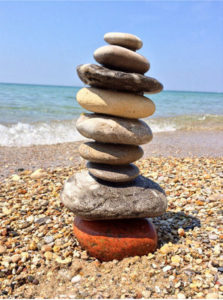 I recently had the privilege of interviewing Kathleen Cameron, MPH, Senior Director of the Center for Healthy Aging, part of the National Council on Aging (ncoa.org), about balance, falls, and health as we age.
I recently had the privilege of interviewing Kathleen Cameron, MPH, Senior Director of the Center for Healthy Aging, part of the National Council on Aging (ncoa.org), about balance, falls, and health as we age.
Kathy told me that older Americans’ falling is one of the most significant public problems today. It’s estimated that 25 to 33 percent of people over the age of 65 fall every year. About 25% of those who fall are injured. Most common are broken wrists or hips. Femur breaks are also common, even though the femur is one of the biggest bones in the body.
Falls are also the leading cause of traumatic brain injury, and can also exacerbate other problems to the point where the person never recovers, and may even die.
Falls certainly account for many trips to the emergency room, hospital stays and courses of rehabilitation. It’s estimated that falls have cost $31 billion every year.
A descending spiral
The fear of falling alone can restrict activities, although most falls occur at home. People become more isolated and fearful of leaving home, which can lead to depression.Those who suffer from depression can fall even more.
You can see the spiral here. A self-fulfilling prophecy. People fear falling so they don’t do the things which can prevent falls, which causes an increased risk of falling.
Good news
The good news is that many falls can be prevented. Staying active, starting as early in life as possible, can prevent falls. Regular exercise, including strength and balance work, also can prevent falls. (And people give me funny looks when I tell them about my balance work…)
Kathy says even entirely healthy people aged 60 and older are more prone to falls than those 10 to 20 years younger. Changes occur to the body in aging that contribute to falls. As we age, we tend to lose muscle mass and strength decreases. To counteract the effect, it’s even more important to combine strength exercises with our cardio and balance!
Pre-existing conditions
Many older Americans also suffer from chronic conditions – heart disease, arthritis, and diabetes – which also contribute to the risk. And medications that are prescribed for these conditions may have side-effects such as dizziness and drowsiness, which contribute to falls.
Once again, though, there is good news. If a healthy and fit 60-year-old does suffer a fall, his or her recovery may be easier than others’. I told Kathy about a recent fall of my own. I stepped on a rock funny in the dark, fell and skinned my shin. 2 weeks later, it’s all better except for a little scab. Kathy said that it’s probably due to the strength and balance work I do that my injuries were not worse and my recovery was so fast.
Practice helps!
Practicing balance truly does help to reduce the risk of falling. But it needs to be practiced on a regular basis – in fact, daily! Tai Chi is one example of exercise that improves strength and balance, but it must be practiced for at least 50 hours before it produces any benefits. Starting early will help later, but it’s never too late to start!
Yoga has not been studied specifically for reducing falls, but if you’re physically able to do it, it certainly can’t hurt. Balance and strength, which yoga improves, reduce the risk of falls.
Balance is a combination of many factors
Kathy said that balance combines many sensory inputs. Input from the eyes, ears, and touch are all integrated through the brain and output through the muscles. All of your senses combine to affect your balance.
Balance also has a psychological component which may be even more difficult to overcome. Fear of falling is a real problem for many. There is an evidence-based program, “A Matter of Balance,” that the National Council on Aging encourages, helps to overcome the psychological effect of the fear of falling. If you or someone you know has a fear of falling, I urge you to contact your local area Agency on Aging and take advantage of this program. Everyone should be able to enjoy the world as much as they want to!
Shoes make the woman (or man)
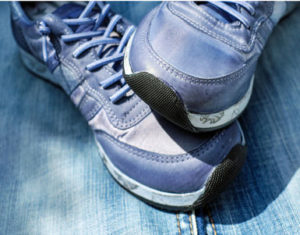 Footwear makes a difference in balance. According to Kathy, high heels significantly increase the risk of falling – no surprise there. But going barefoot or in socks at home also increase the risk, due to a higher risk of slipping. Low-heeled shoes with firm, slip-resistant soles like rubber are recommended. And be sure to wear your glasses, even at home!
Footwear makes a difference in balance. According to Kathy, high heels significantly increase the risk of falling – no surprise there. But going barefoot or in socks at home also increase the risk, due to a higher risk of slipping. Low-heeled shoes with firm, slip-resistant soles like rubber are recommended. And be sure to wear your glasses, even at home!
Vision plays a very big role in balance. Everyone should have their vision checked every year, and have their corrective lenses adjusted. Your home should be properly lit. Don’t sit in the dark! If you can’t reach a burnt-out light bulb, ask for help. Don’t climb on things to change it! Have a clear, well-lit path from the bedroom to the bathroom. There are attractive modern switches that dim or light a path. Use one!
Weighty matters
The obesity epidemic in America is also a factor in falls. People who are obese may be less physically active, they may not be as strong and their balance may not be as good. Kathy said, many obese people who fall feel hopeless and helpless, feeling that nothing can be done for them. Again, increasing the risk of more falls.
Obese people suffer from diabetes and arthritis at a higher rate, which leads to more pain and discomfort, which limits their activity, and increases the number of prescription medicines they’re on, according to Kathy. Some of these medications’ side effects increase the risk of falling. Pain medicine, for example, produces side effects such as sleepiness and dizziness, leading to more falls. Obese people also tend to be more depressed. Anti-depressant medication also increases the risk of falls. More dark spirals.
Common medications may increase your risk
 Many older Americans are on some form of medication that contributes to falls. Kathy says that even some common prescriptions can increase your risk because they are psychoactive in nature and affect the central nervous system.
Many older Americans are on some form of medication that contributes to falls. Kathy says that even some common prescriptions can increase your risk because they are psychoactive in nature and affect the central nervous system.
Many opioid pain medications increase the risk. So do insomnia medications such as benzodiazepines, and blood pressure medication. As we get older, our bodies don’t flush out medicines as quickly as when we’re young. Dosage could be a factor that increases our risk of falling. Get your medications checked on a regular basis.
Get your orthostatic blood pressure checked – sitting versus standing. If there’s a significant drop when you stand up, that could be a problem in your medications or their dosage. Our bodies’ response to medication changes as we age.
Even over-the-counter medications can also increase your risk of falling. The active ingredient in Benadryl and other antihistamines can lower your blood pressure, causing you to be dizzy and fall. It’s also found in sleep medicine that you can buy over the counter. Non-sedating allergy medicines are recommended, especially for people over 60 and those with a higher risk of falling.
What to do
In terms of exercise, walking alone doesn’t reduce falls, Kathy says. Walking is certainly important for cardiac benefits, but it should be done in conjunction with strength and balance work. The CDC recommends 20 minutes or so of vigorous activity 4-5 times a week, and moderate- or high-intensity strength work 2 days a week that involve all muscle groups.
Before anyone starts an exercise program they should check with their doctor and start slowly. Set realistic goals and build slowly. If you haven’t exercised in the past, the “Stay Active and Independent For Life” (SAIL) program is good for older adults. Then progress to “EnhanceFitness” and “A Matter of Balance.” These are evidence-based programs and are promoted by the National Council on Aging.
On a personal note, I add balance work to my regular exercise, which combines cardio and strength work.
Draft your doctor to help
If you’ve been to the doctor and had a bone density test, and you’re fine – Kathy says don’t be complacent! Falls are caused by many factors. At your next visit, ask your doctor for a falls-risk screening and assessment. Be pro-active and know your risks. Less than half of older Americans talk to their doctors about falls and their risks, not realizing their doctors can help.
What’s our take-away?
Be active and stay active! Be sure to follow the CDC’s guidelines on exercise, and add strength and balance work to your regimen. Contact me for suggestions!
If you’re overweight and fall into the “obese” category, get physical and psychological support. We want you to be healthy!
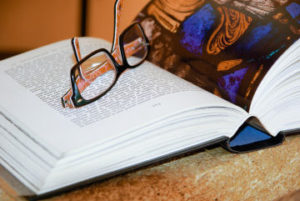 Talk to your doctor about fall prevention, especially if you have fallen, have a fear of falling, or feel unsteady on your feet.
Talk to your doctor about fall prevention, especially if you have fallen, have a fear of falling, or feel unsteady on your feet.
Have your prescriptions monitored for interactions and side-effects that contribute to falls.
Get your vision checked once a year and your corrective lenses adjusted accordingly.
And turn your lights on!
Wear safe shoes – there are some cute ones out there… I checked.
Join my Facebook Balance Community – Balance for Fitness, Balance for Life!
Be sure to subscribe to Fran’s newsletter for news, tips, recipes and (sometimes) fun stuff!
Stay in control of your falls risk. You have the power to prevent a fall!
Like exercise? Not me…
 Many of you may be under the mistaken impression that I like to exercise. Ummmm… no. I post exercise pictures, sweaty selfies, my crazy circus moves (like the side plank, left) to motivate myself and anyone else who might be inspired to follow my example. But like exercise? No.
Many of you may be under the mistaken impression that I like to exercise. Ummmm… no. I post exercise pictures, sweaty selfies, my crazy circus moves (like the side plank, left) to motivate myself and anyone else who might be inspired to follow my example. But like exercise? No.
Why?
I exercise because I like to do other things.
I want to be able to train my dogs and compete with them in not only obedience, where you just have to run for a short distance, but in agility as well, where you run for a minute or so – remembering an obstacle course, and directing your dog to do those obstacles.
I want to take hikes in pretty places. and I want to be able to travel to those pretty places, preferably without pain and on my own two feet.
I don’t like to shop, so I want to spend as little time in grocery stores as possible. That means to check the produce myself and pick the good stuff, select all the other things necessary, maneuver my cart through the store, take the stuff out of the cart, put it in my car, bring it in my house and put it away myself.
I want to cook delicious meals for myself, my family and my friends. That means being on my feet for an extended period of time.
I want to go out with friends and family and not worry about being a hindrance to them.
I want to eat good food!
Exercising burns calories, so I can eat more good food. Including desserts (especially chocolate)!
I want to use my brain!
And I want to keep my cognitive function for as long as possible.
Short, effective workouts
So I exercise. I don’t particularly like it, but I do it. I’ve found that combining cardio and strength for a very intense 30 minutes 4 or 5 times a week is quite effective at keeping my joints happy, the weight off, and my brain going. 21 Day Fix Extreme works for me most of the time. (I find it easier on my knees than 21 Day Fix.) Every couple of months I do PiYo for a week, just for something different. But I don’t exercise to be entertained. I exercise for the outcome.
So, there you have it. I don’t like to exercise, but I do it.

